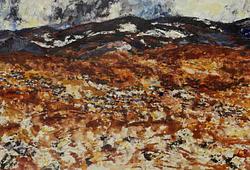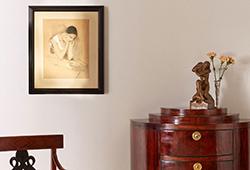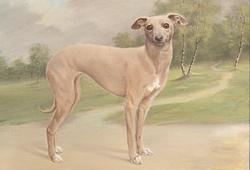Sylvia Sleigh
"Mel Pekarsky Tondo"
Executed in 1961. Oil on canvas 43.5 cm in diameter.
Alkuperä - Provenienssi
Freymond-Guth, Schweiz. Acquired in 2011.
Näyttelyt
Kunstnernes Hus Oslo, "Sylvia Sleigh", 11 May - 15 July 2012.
Kunst Halle Sankt Gallen, "Sylvia Sleigh", 6 October - 2 December 2012.
CAPC, Musée d'Art Contemporain de Bordeaux, "Sylvia Sleigh, A Visceral Eye", 16 May - 1 September 2013.
Tate Liverpool, "Sylvia Sleigh", 8 February - 3 May 2013.
Centro Andaluz de Arte Contemporáneo, Sevilla, "Sylvia Sleigh, The Untimely Gaze", 27 September 2013 - 12 January 2014.
Muut tiedot
Sylvia Sleigh has, in her many period-defining portraits, succeeded in capturing the New York art and cultural scene of the 1960s and 70s. Her realistic and detailed paintings portray her friends and acquaintances amongst the cultural personalities, career-climbing artists and academics of the time. She documented central characters of the Second Wave feminist movement in art and worked for female artists’ rights and opportunities. She was, for example, one of twenty female artists that founded the artist run organisation SOHO20 Gallery. Her works are also records of a particular time, as she very carefully reproduced what was then the fashion in clothes, hairstyles and interiors. The round portrait in the auction depicts the artist and professor Mel Pekarsky Tondo. He is portrayed with a typical seventies moustache and is depicted against what would have been a traditionally female-coded backdrop of beautiful flowers. The willow in the background can be found in several of Sleigh’s paintings, like in The Willow: Silvia Castro from 1974. Similar portraits are included in, for example, the collections of MoMA.
Many of Sleigh’s paintings are personal feminist comments on famous paintings from art history by, amongst others, Titian, Ingres and Velázquez. What these references share is that they are portraits or scenes where women are posed naked. She was bothered by the way women had been reproduced in art history and wanted, in a way, to modernise portraiture by creating empathetic and respectful portraits where the model wasn’t objectified. “I made a point of finding models [in the 60s], and I painted them as portraits, not as sex objects, but sympathetically as intelligent and admired, not as women had so often been depicted as unindividuated houris [beautiful young women]. I had noted from my childhood that there were always pictures of beautiful women but very few of handsome men, so I thought it would be truly fair to paint handsome men for women.”
A few years after Sleigh’s death (aged 94) in 2010 a very comprehensive and major retrospective exhibition of her work was organised. She was, as previously mentioned, mostly known for her portraits, but she also painted still lifes and landscapes, which the audiences were now able to view in the touring exhibition that passed Kunstnernes Hus Oslo, Kunst Halle Sankt Gallen in Switzerland, Tate Liverpool, CAPC Musée d’Art Contemporain de Bordeaux, France, and Centro Andaluz de Arte Contemporáneo, Sevilla.
Quote from kunstnerneshus.no





























